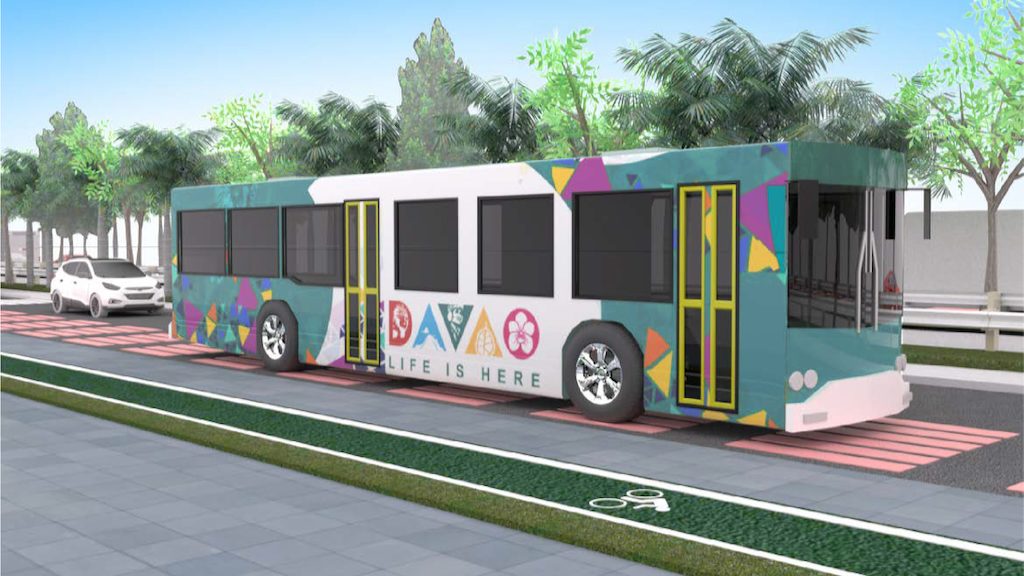SUMMARY
This is AI generated summarization, which may have errors. For context, always refer to the full article.

MANILA, Philippines – The ambitious Davao Public Transport Modernization Project (DPTMP), which will cost a whopping P74.3 billion, promises everything from proper bus stops to electric buses plying routes all over Davao City and its adjacent areas.
The DPTMP has been tagged as a “game-changing project” by President Ferdinand Marcos Jr., while Transportation Secretary Jaime Bautista said it marks the “metamorphosis of public transport in the whole of Mindanao, starting here in Davao City.”
So, what’s behind the DPTMP, and how far along are we?
Inspired by the EDSA Carousel, the DPTMP will set up a “network of efficient PUV (public utility vehicle) operations across Metro Davao and nearby communities.” The 672-kilometer bus system will have “nine feeder routes, eight routes to inner urban areas and links between outer rural areas and terminals in Davao City, Panabo City, and Davao del Norte,” with over 1,000 bus stops, three interchange terminals, and five bus depots, according to a press release by the Department of Transportation (DOTr).
Previously, the DOTr said the Davao buses would have a “core service lane” that connects to major commercial areas, similar to EDSA’s bus lane which is separated from normal road traffic by concrete barriers. However, the agency later clarified on Saturday, February 10, that the DPTMP “will not require dedicated bus lanes separated by concrete barriers,” unlike the EDSA Busway.
Davao’s bus fleet is also expected to be cleaner. More than 380 “articulated electric buses” will service the metro Davao routes while 531 regular and 188 mini-buses – which will have Euro 5-standard diesel engines – will service the other bus routes. Buses will be run by private bus operators.
The project also promises an automatic fare collection system, with Wi-Fi in buses and terminals.
Bankrolling the DPTMP is a $1-billion loan from the Asian Development Bank (ADB), which says it is the multinational lender’s “largest road-based public transport project in the Philippines.”
What’s the progress?
To be clear, the Davao bus project’s implementation is just at the starting line, with Transportation Secretary Bautista signing four civil works contracts for it on Wednesday, February 7.
China International Water and Electric Corporation snagged contract packages 1, 2, and 3, which covers:
- Contract Package 1 – Design and build contract for Buhangin, Calinan depots, and Calinan driving school
- Contract Package 2 – Design and build contract for Toril bus depot, and Bunawan, Calinan, and Toril bus terminals
- Contract Package 3 – Design and build contract along bus routes including bus stops, bus lanes, and other pedestrian improvement works
Meanwhile, the joint venture between subsidiaries of Fujian Construction and Vicente T. Lao Construction won the fourth contract package, which covers the design and build contract for Sasa and Sto. Niño e-bus depots.
The DOTr expects partial operation of the Davao buses to start by the fourth quarter of 2025, with full operations targeted later in 2026.
Once operational, it is expected to serve 800,000 passengers a day.
Is Davao exempted from PUV modernization?
Once in full swing, the project will rationalize more than 120 jeepney routes into around 30 bus routes. According to the ADB, a social development program will “mitigate any adverse impacts and risks related to the restructuring of Davao City’s transport sector.”
“The assistance will include livelihood opportunities for affected public utility jeepney drivers, operators, and allied workers and their families, among others,” the ADB said in a press release.
But given that the Davao bus project isn’t expected to be operational until 2025, jeepneys in Davao City and surrounding areas will not be covered yet by the strict deadlines set by the Public Utility Vehicle Modernization Program (PUVMP).
“Provisional authority issued to individual operators and consolidated [transport service entity] of [public utility jeepney] routes affected by the Davao Public Transport Modernization Project shall continue to be valid until the deployment of [public utility bus] units under the abovementioned project,” the Land Transportation Franchising and Regulatory Board said in a board resolution.
However, the DOTr emphasized that this doesn’t mean Davao is exempted from the controversial program and the mandatory industry consolidation of jeepneys, which will continue at a later date. Instead, the bus project in Davao is expected to be “separate yet complementary” to the government’s PUVMP. – Rappler.com
Add a comment
How does this make you feel?


![[The Slingshot] Lito Patay’s 4 hours and 38 minutes of infamy](https://www.rappler.com/tachyon/2024/07/Lito-Patay-4-hours-infamy-July-19-2024.jpg?resize=257%2C257&crop=233px%2C0px%2C720px%2C720px)

![[Pastilan] The Great Philippine Identity Sale](https://www.rappler.com/tachyon/2024/07/great-philippine-identity-sale-july-16-2024.jpg?resize=257%2C257&crop=486px%2C0px%2C1080px%2C1080px)


![[Under 3 Minutes] When will we see modern jeepneys on the road?](https://www.rappler.com/tachyon/2024/04/francisco-motors-modern-jeepney-prototype-1.jpg?resize=257%2C257&crop=590px%2C0px%2C1012px%2C1012px)


There are no comments yet. Add your comment to start the conversation.